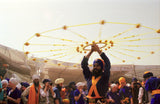Golden Temple: For a Once-in-a-Lifetime Experience of Spirituality and Unity
Golden Temple is a spiritual and religious marvel located in Amritsar, Punjab state of India. Known for its stunning white marble architecture, golden coating, and mega kitchen, this place attracts millions of devotees and tourists from all regions of the world. Golden Temple is not just a place to worship God. It also symbolizes unity because it welcomes people of all ethnicity, religions, and colors without any discrimination.
If you wonder why is the Golden Temple important to Sikhism and why you should visit this place, you are in the right place. Here, we are going to introduce you to the divine and ethereal Golden Temple.
A Quick Look at the History of Golden Temple
Also known as Harmandir Sahib and Darbar Sahib, Golden Temple is the chief pilgrimage site for Sikhism. Guru Arjun Dev, the fifth Sikh Guru, gave the idea of creating a central place for Sikhs to worship. The land for the gurudwara was acquired by Guru Sahibs from the landlords of native villages, including Tung, Sultanwind, Gilwali, and Gumtala.
Guru Arjan initiated the construction work in 1581, and it was completed in 1604. He had the gurudwara placed on a lower level than the city so that everyone had to step down to enter the premises before connecting with the divine. He also included four gates, one in each direction, of the gurudwara compound, signifying that the premises were open to people of all castes and creeds.
It is believed that Guru Arjan invited a Sufi saint Hazrat Mian Mir to lay the foundation stone of the gurudwara, signaling that the Sikh tradition welcomed all. In the history of the Golden temple, the shrine was damaged several times by Afghan invaders. Finally, Maharaja Ranjit Singh, the first Maharaja of the Sikh Empire, rebuilt the Golden Temple in marble, copper, and gold. The gold plating of the shrine was accomplished in 1830.
In 1984, Golden Temple sustained some damage when Indian troops entered the temple to dislodge Sikh extremists who had been using the premises as a refuge.

Golden Temple is located in the heart of the Amrit Sarovar (Pool of Nectar) and is connected to the land on one side by a marble causeway. The Akal Takht (main center of Sikhism authority) and the head of the Shiromani Akali Dal are situated facing the entrance of the causeway. On the north of the pool is the main entrance to the gurudwara and the Teja Singh Samudri Hall (Clock Tower). On the east side, there are several buildings, including the Assembly Hal and the Guru Ram Das Langar.
The Marvellous Architecture of the Golden Temple
Over the centuries, the architecture of the Golden Temple has undergone numerous renovations and additions, resulting in the breathtaking structure we see today. At present, the architecture of gurudwara reflects a mixture of different styles, particularly Hindu-Rajput and Indo-Islamic architecture. The main building of the Golden Temple is surrounded by a large pool of water known as the Sarovar. The Sarovar is considered a sacred body of water and is believed to have healing powers. Pilgrims who visit the Golden Temple often take a dip in the Sarovar as part of their spiritual journey.
The main entrance of the Golden Temple is a massive archway made of white marble, known as the Darshani Deori. Above the archway is a beautiful golden dome, which is adorned with intricate carvings and decorations. The 750 kg gold gilded dome is topped with a golden finial, known as the Kalash, which is a symbol of Sikh sovereignty.

Inside the main building of the Golden Temple, there is a large prayer hall known as the Harmandir Sahib. On the ground floor is the Shri Guru Granth Sahib, placed under a splendid canopy. The walls and ceilings of the prayer hall are covered in intricate frescoes and carvings, which depict scenes from Sikh history and mythology. The floor of the prayer hall is made of marble and is covered with a beautiful carpet, which has been changed several times.
On the second storey is a Mirror Room or Shish Mahal decorated with small pieces of mirrors in different shapes and sizes.
Guru Ka Langer – the World’s Largest Community Kitchen

Open 24 hours, year around, Golden Temple’s kitchen serves vegetarian meals to around 100,000 people for free every day. So, the Sikh Shrine satiates not just the soul but also the stomach. Another surprising thing about the kitchen is that it is entirely run by volunteers who work free of cost.
Selfless service is integral to Sikhism. So, hundreds of religious volunteers work round-the-clock to keep the kitchen running. From peeling vegetables to serving and cleaning the gurudwara compound, everything is volunteer-run. Some volunteers work for a few hours, some for a day and some for weeks, and some for a lifetime in exchange for Guru's blessings.
The kitchen uses around 12000 kg of flour, 1500 kg of rice, 13000 kg of lentils, and 2 000 kg of vegetables daily. It takes an army of men and women to prepare the meal. You will see men stirring the vessels bubbling with lentils, women rolling out rotis, and some people flipping rotis over a large hot plate.

To keep up with demand, the work of cooking chapatis (roti) is split between machines and rolling by hand.
Constructed over 50,000 sqft, the Guru Ramdas Langar Hall is the place pilgrims are fed. The space can accommodate 50,000 people at a time. Collect your plates, sit on the floor, and the food will be served to you with love and respect.
It now costs over 4 million dollars a year to keep the kitchen running. But with a constant stream of donations and support, the langer has kept up with demand no matter the number of visitors.
Today, it costs more than 4 million dollars per year to run the kitchen smoothly. But with the constant blessings of Guru, donations, and support, the langer has successfully kept up with the growing number of visitors.
Golden Temple: A Sign of Unity
Sikhism is a religion that was founded on the principles of unity, equality, and justice. The Golden Temple embodies these principles and serves as a reminder of unity in Sikhism and in the world at large. The gurudwara is open to people of all religions, castes, and creeds, and everyone is welcome to come and offer prayers, partake in the langar (community kitchen), and experience the peace and serenity of the holy shrine.
The architecture of the Golden Temple is also symbolic of unity. Four entrances of the gurudwara represent the openness and inclusiveness of Sikhism. The doors face all four directions, signifying that people from all corners of the world are welcome to enter and seek the blessings of Waheguru (God). The central dome of the gurudwara represents the oneness of God, while the surrounding smaller domes represent the unity of all religions.
Another way that the Golden Temple symbolizes unity is through the langar that serves food to all visitors, regardless of their religion, ethnicity, caste, or social status. By providing food to people from all walks of life, the langar embodies the Sikh principle of seva (selfless service) and promotes unity and equality.
Experiencing Spirituality Inside the Golden Temple
The spirituality of the Golden Temple is palpable, and it is the reason why the shrine attracts millions of devotees every year. The temple, which is open 24 hours a day, is a place of peace and tranquillity. The serenity of the temple is amplified by the gentle sounds of the kirtan (devotional hymns) that are played throughout the day.
The atmosphere inside the temple is one of reverence and devotion, and visitors are encouraged to participate in the rituals that take place there. The most important of these rituals is the recitation of the Guru Granth Sahib, the holy book of the Sikhs, which takes place in the main prayer hall. Visitors are welcome to sit and listen to the recitation, which is usually accompanied by kirtan. Everyone is welcome to enter the temple's inner sanctum and offer prayers.
Another essential ritual that takes place in the Golden Temple is the distribution of prasad, which is a sweet, blessed food that is distributed to devotees at the end of the prayer service. The prasad is a symbol of the Guru's blessings, and it is believed to have the power to cure illnesses and bring good luck.
Parting Thoughts
By now, you must know why is the Golden Temple important. If you ever get a chance to visit the heavenly place, you are sure to be impressed by the divine feeling of spirituality and peace you will experience within the premises.
Golden Temple is a place of incredible beauty and unmatched tranquillity.
Pilgrims to the shrine frequently experience calmness and contentment. This religious heritage spreads the message of humble living, equality, and peace by encouraging openness and interaction. The Golden Temple is, without a doubt, a stunning and inspirational tourist destination, both domestically and all over the world.



